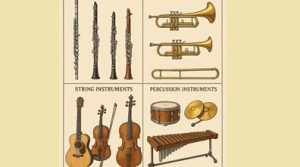Let’s Talk About Music
Let’s Talk about Music: Music is a widespread art form that blends rhythm and sound to create compelling melodies.
It transcends time, space, and culture, conveying emotions and moods without words.
Music can be preserved through a written language unique to its art, allowing it to be shared and understood universally.

Creating great music involves more than just advanced tools and equipment—it requires a solid understanding of the language of music.
Whether you’re crafting dynamic beats, catchy tunes, or intricate soundscapes, mastering music theory can take your creations to new heights.
This guide will explore essential concepts like rhythm, melody, harmony, scales, keys, and song structure, equipping you with the knowledge to create better music using tools like Pro Tools.
Let’s Talk About Music: What Is Music Theory?
Music theory is the study of the foundational elements that define and shape the language of music, such as notes, scales, chords, rhythm, melody, harmony, and form.
It provides musicians with a framework to create, analyze, and interpret musical compositions.
Although the term may sound intimidating, even a basic understanding of music theory can enhance your ability to produce, compose, and appreciate music on a deeper level.
In essence, music theory explores the building blocks of music, including harmony, melody, and rhythm.
It also helps musicians interpret musical qualities like pitch, tone, texture, and dynamics, making it an invaluable tool for artists across genres, from electronic to pop music.
Let’s Talk About Music: Learning Music Theory
Music theory is an extensive subject with many concepts and practices, but starting with the basics is the best approach.
Begin by focusing on the core elements of music:
- Harmony
- Melody
- Rhythm
Building a strong foundation in these areas will make it easier to grasp more advanced music theory concepts.
About Music: Key Elements of Music Theory
Harmony
Harmony occurs when multiple notes or voices are played together to create a pleasing or contrasting sound. Examples include chords and chord progressions, where three or more notes are played simultaneously to complement a melody.
Harmonies can also be created by blending vocal parts, as in a choir.
There are two main types of harmony:
- Consonant harmony: produces stable, pleasing sounds with intervals like unison, thirds, and fifths.
- Dissonant Harmony: Adds tension with less pleasant-sounding intervals like seconds and sevenths, which resolve into consonant chords to create a dynamic listening experience.
Melody
A melody is a series of notes or voices arranged into a memorable musical phrase. It is often the most recognizable aspect of a song, created through a combination of pitch and rhythm.
- Pitch: The highness or lowness of a sound.
- Rhythm: The duration of each pitch, organized into patterns like quarter notes or triplets.
Melodies can move in two ways:
- Conjunct Motion: Notes move by small, stepwise intervals, making them easier to sing or play.
- Disjunct Motion: Notes leap by larger intervals, adding complexity but making the melody less smooth.
Rhythm
Rhythm refers to the time-based aspect of music, defined by patterns of notes and silences. It involves:
- Beat: The basic pulse of a musical piece.
- Meter: A repeating pattern of strong and weak beats.
- Time Signature: Defines the number of beats per measure.
- Tempo (BPM): Determines the speed of the music.
- Syncopation: emphasizes offbeats to create rhythmic variation.
- Accents: Highlights specific beats or notes for emphasis.
Rhythm serves as the backbone of music, driving the flow of melodies and harmonies.
About Music: Benefits of Music Theory
Learning music theory enhances creativity, deepens musical understanding, and simplifies the production process.
While not mandatory, understanding music theory can provide invaluable tools for composing and producing music, making it a worthwhile skill to develop.






Can you be more specific about the content of your article? After reading it, I still have some doubts. Hope you can help me.
Thank you for your sharing. I am worried that I lack creative ideas. It is your article that makes me full of hope. Thank you. But, I have a question, can you help me?
I don’t think the title of your article matches the content lol. Just kidding, mainly because I had some doubts after reading the article. https://www.binance.info/en/register?ref=JHQQKNKN
888Starz is a popular online gaming and betting platform that combines sportsbook, casino games, live dealers, and esports in one place, offering players from around the world a complete and exciting entertainment experience.
888starz link [url=http://www.888starz-bet-casino.com/pl]https://888starz-bet-casino.com/pl/[/url]
Если вам нужна [url=https://konsultaciya-yurista121.ru]бесплатная консультация юриста по телефону горячая линия|адвокат|бесплатные консультации юриста по телефону в москве|помощь юриста бесплатно по телефону|юридическая консультация бесплатно по телефону круглосуточно|консультация юриста бесплатно по телефону|бесплатные юридические консультации|бесплатные юристы в москве|юрист онлайн бесплатно|бесплатные консультации юриста онлайн без регистрации[/url], не стесняйтесь обратиться к нам!
Квалифицированные юристы из konsultaciya-yurista121.ru готовы помочь вам в решении различных правовых вопросов. Мы предлагаем широкий спектр услуг , включая консультации, представительство в суде и помощь в составлении документов.
При обращении к нашим юристам, вы можете рассчитывать на высококачественное обслуживание. Каждый клиент для нас важен, и мы стремимся найти оптимальное решение . Наша цель – сделать процессы максимально прозрачными и понятными.
На konsultaciya-yurista121.ru вы можете ознакомиться с отзывами наших клиентов . Мы предоставляем полезные советы и рекомендации. Также у нас есть блоги с юридическими новостями , которые помогут вам быть в курсе последних изменений в законодательстве.
Связываясь с нами , вы можете задать все интересующие вас вопросы. Чем быстрее вы обратитесь, тем больше шансов на положительный результат . Ваши права и интересы должны быть защищены .